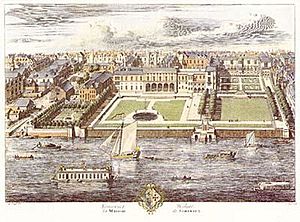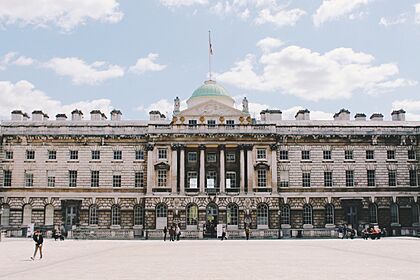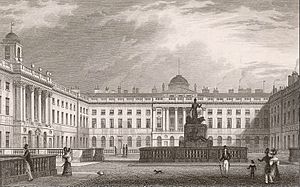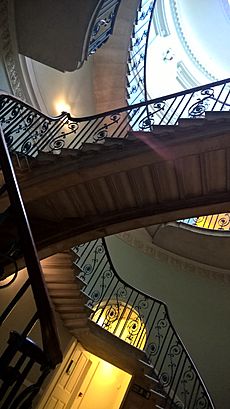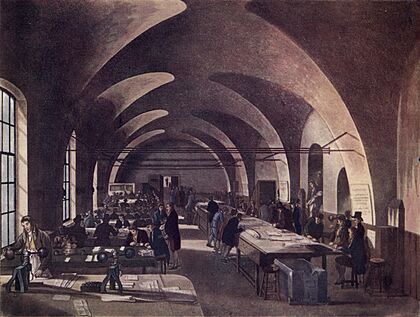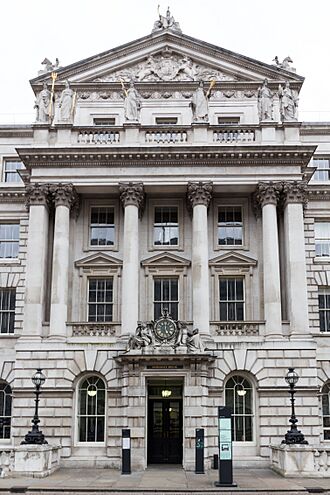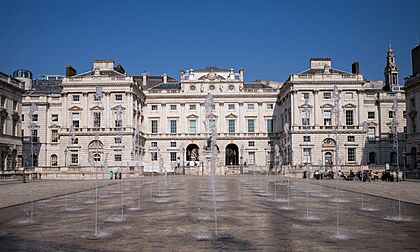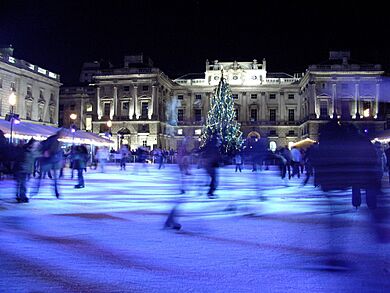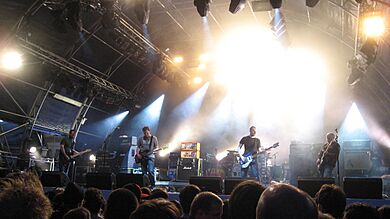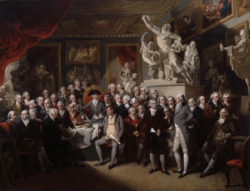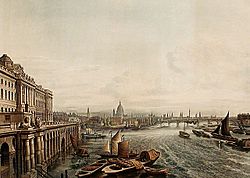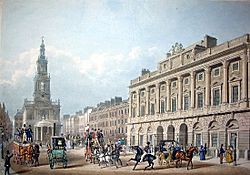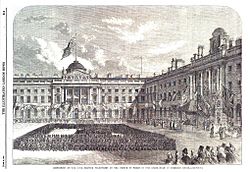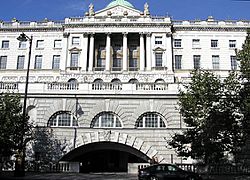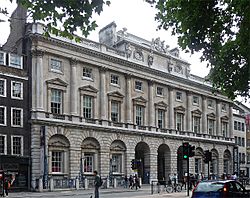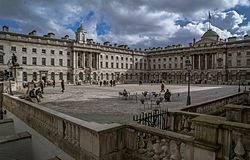Somerset House facts for kids
Quick facts for kids Somerset House |
|
|---|---|
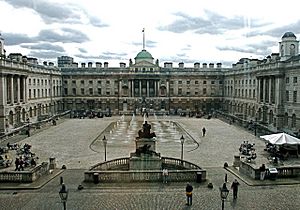
Courtyard of Somerset House from the North Wing entrance (September 2007)
|
|
| General information | |
| Architectural style | Renaissance |
| Location | Strand London, WC2 |
| Country | United Kingdom |
| Current tenants | Multiple |
| Construction started | 1776 |
| Cost | £462,323 (1801) |
| Landlord | Somerset House Trust |
| Design and construction | |
| Architect | Sir William Chambers |
| Designations | Grade I listed building |
Somerset House is a very large and impressive building in central London. It stands on the south side of the Strand and looks out over the River Thames. This grand building was designed in a style called neoclassical.
The current Somerset House was built where an older palace once stood. That palace belonged to the Duke of Somerset during the Tudor times. The new building was designed by Sir William Chambers and construction began in 1776. Later, more parts were added in the 1800s. Until the 1860s, the River Thames flowed right up to the building.
Somerset House was originally built to hold many important government offices and public groups. Today, it is home to various organizations, mostly focused on arts and education.
Contents
The Old Somerset House
A Royal Palace (1500s)
In the 1500s, the area along the Thames known as the Strand was a popular spot for wealthy people to build their homes. In 1539, Edward Seymour received land from King Henry VIII. When his nephew, King Edward VI, became king in 1547, Seymour became a powerful figure called the Duke of Somerset.
Around 1549, he started building a huge palace for himself. He even used materials from other old buildings that were being taken down. This new palace was one of the first examples of Renaissance architecture in England. It had two floors and was built around a central courtyard.
However, the Duke of Somerset was removed from power before his palace was finished. In 1552, he was executed. The palace then became property of the Crown. Queen Elizabeth I lived there for a time before she became queen. The building took a long time and a lot of money to finish.
Royal Residents and Important Events (1600s-1700s)
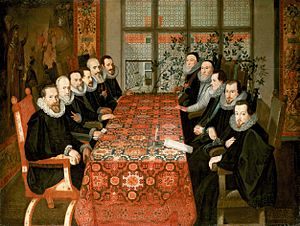
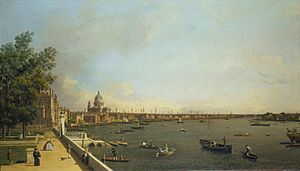
In 1604, Somerset House was the place where important talks happened to end the war between England and Spain. This led to the Treaty of London.
During the 1600s, the palace was often used by the wives of kings. Anne of Denmark, wife of King James I, lived there and renamed it Denmark House. She added many expensive improvements, some designed by the famous architect Inigo Jones. She even had a special fountain built with a statue of Pegasus.
Later, Henrietta Maria of France, wife of King Charles I, had a Catholic chapel built there between 1630 and 1635.
During the English Civil War, the palace was taken over by Parliament. General Fairfax, the Parliamentarian commander, lived there. Later, Lord Protector Oliver Cromwell's body lay in state at Somerset House after he died in 1658.
After the monarchy was restored, Queen Henrietta Maria returned and started more rebuilding, including a beautiful new riverfront designed by Inigo Jones. After her, Catherine of Braganza, wife of King Charles II, used it occasionally.
By the 1700s, the building was no longer used by royalty and began to fall apart. It was used for storage and as a place for visiting guests. The old Somerset House started to be torn down in 1775.
The New Somerset House (Sir William Chambers, 1776)
| Crown Lands Act 1775 | |
|---|---|
| Act of Parliament | |

|
|
| Long title | An Act for settling Buckingham House, with the Appurtenances, upon the Queen, in case She shall survive His Majesty, in lieu of His Majesty's Palace of Somerset House; for enabling the Lords, Commissioners of His Majesty's Treasury to sell and dispose of Ely House in Holborn, and for applying the Money to arise by Sale thereof, together with other Monies, in erecting and establishing Publick Offices in Somerset House; and for embanking certain Parts of the River Thames, lying within the Bounds of the Manor of The Savoy, and for other Purposes therein mentioned. |
| Citation | 15 Geo. 3. c. 33 |
| Dates | |
| Royal assent | 26 May 1775 |
In the mid-1700s, people felt that London needed more grand public buildings. Government offices were scattered in small, old places. So, in 1775, Parliament passed a law to build new public offices at Somerset House. This law also allowed for the riverbank to be built up along the Thames.
The new Somerset House was designed by Sir William Chambers, a very important architect. He spent the last 20 years of his life working on the building. Thomas Telford, who later became a famous engineer, also worked on its construction.
Design and Construction
Chambers designed the new Somerset House in the Palladian style, which was popular at the time. The building was shaped like the old palace, stretching from the Strand down to the river. His final design included a large central courtyard, about 300 feet long and 200 feet wide. The building had a grand front facing the river, about 500 feet wide.
Each part of the building around the courtyard had six floors. The upper floors often provided living spaces for officials. Large underground rooms were built to store important public documents.
The North Wing, facing the Strand, was built first and was finished by 1780. The riverside wing was completed in 1786. At that time, the river came right up to the South Wing, and boats could even enter through a large arch. Work continued on the East and West Wings, and the main courtyard was finished by 1790.
The original plan included two rows of houses on either side of the main building, but only the western one was built. By 1801, the building was considered complete, costing a lot of money for that time.
The outside of Somerset House was decorated with many sculptures. These included a bronze group of statues of Neptune and George III in the main courtyard. Inside, some of the important rooms had beautiful painted ceilings and decorative plasterwork.
What Was Inside?
The main reason for building the new Somerset House was to provide space for many different important groups and government offices.
Arts and Learning
The North Wing of Somerset House was home to important groups like the Royal Academy, the Royal Society, and the Society of Antiquaries. The Royal Academy, which is a famous art institution, held its annual art exhibitions here from 1780.
Other scientific groups, like the Geological Society and the Royal Astronomical Society, also had offices in Somerset House. Over time, these groups moved to other locations, and their spaces were used for other purposes, like a Government School of Design.
In 1789, the Navy Board, which managed the Royal Navy, moved into grand rooms in the South Wing. Other Navy departments also moved into the West Wing. Somerset House was where young sailors took their exams to become lieutenants. It also housed an early version of the National Maritime Museum.
In 1832, the Navy departments were reorganized and eventually moved out of Somerset House by 1873. Their space was then taken over by the expanding Inland Revenue.
Taxes and Stamps
From the very beginning, Somerset House was involved with taxes. The Stamp Office and the Tax Office were located here. The Stamp Office put special stamps on items like newspapers to show that taxes had been paid. The Tax Office collected various taxes, including income tax.
In 1849, the Stamp and Tax Offices merged to form the Inland Revenue. This department continued to use Somerset House for many years. By 2013, all tax staff had moved out, ending a 224-year connection between tax services and Somerset House.
The Somerset House Laboratory
In 1842, a laboratory was set up to test products like tobacco for purity. This became the Inland Revenue Laboratory, also known as the Somerset House Laboratory. It tested many different things, including food, beer, and spirits. In 1897, this laboratory moved to a new building and was renamed the Government Laboratory.
Births, Marriages, and Deaths
From 1837, the office that kept records of all births, marriages, and deaths in England and Wales was located in the North Wing of Somerset House. This important connection lasted for over 130 years until 1970, when the records moved to a new location.
Other Offices
Many other government offices were also housed in Somerset House over the years. These included offices for licensing hackney coaches (taxis) and traveling traders, and offices related to the royal estates like the Duchy of Cornwall and the Duchy of Lancaster. Important historical records were also stored in the basements.
Later Changes (1800s-1900s)
The building continued to grow. King's College London was built next to the East Wing between 1829 and 1834, following Chambers' original design. Later, between 1851 and 1856, the western side of the building was greatly expanded to create a "New Wing" for the Inland Revenue.
During the Second World War, Somerset House was hit by bombs during the London blitz. Some parts, including a beautiful staircase, were destroyed. These damages were repaired in the 1950s.
| Somerset House Act 1984 | |
|---|---|
| Act of Parliament | |
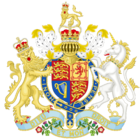
|
|
| Long title | An Act to confer leasing powers on the Crown in respect of the Fine Rooms and other parts of Somerset House with a view to their use for artistic, cultural or other purposes. |
| Citation | 1984 c. 21 |
| Dates | |
| Royal assent | 26 June 1984 |
|
Status: Current legislation
|
|
| Text of statute as originally enacted | |
| Text of the Somerset House Act 1984 as in force today (including any amendments) within the United Kingdom, from legislation.gov.uk | |
In 1984, a new law was passed to allow Somerset House to become a center for the arts. In 1997, the Somerset House Trust was created to manage the building and develop it as a place for arts and culture. The Courtauld Institute of Art, with its important art collection, moved into the North Wing in 1989.
Somerset House Today
The main courtyard, which used to be a car park, and the terrace overlooking the Thames were renovated and opened to the public. A visitor center, shop, and café were also added. For a time, the Gilbert Collection of decorative arts and the Hermitage Rooms, which showed items from the Hermitage Museum in Russia, were also located here.
Since 2013, the Somerset House Trust has managed the entire complex. They rent out the upper floors to "creative businesses" and use the ground floor for public activities. The trust uses money from rent and events to maintain the building and fund its art and culture programs.
In the winter, the central courtyard becomes a popular open-air ice rink. At other times, 55 water jets create dancing fountains.
The courtyard is also used for concerts, with a "Summer series" of music events held each July.
Today, Somerset House has over a hundred tenants, including many creative organizations and artists. King's College London is a major tenant, with its law school and other departments in the East Wing.
Filming Location
Somerset House is a popular place for filming movies and TV shows. Its exterior has appeared in several big Hollywood films, including two James Bond movies, GoldenEye (1995) and Tomorrow Never Dies (1997). Scenes from Shanghai Knights (2003) and The Duchess (2008) were also filmed there.
It has also been used in Sherlock Holmes films, such as Sherlock Holmes (2009). The tunnels under Somerset House were even used for some scenes in the Harry Potter films, showing parts of 'Diagon Alley'.
Fire Incident
On August 17, 2024, the London Fire Brigade responded to a large fire on the roof of Somerset House. The fire was in the building's west wing, which contained offices and facilities, not artworks.
Gallery
-
The Royal Academicians in General Assembly by Henry Singleton, 1795, when Somerset House hosted the Royal Academy
-
Somerset House in 1817, showing how the Thames originally flowed directly past the building, before the construction of the Victoria Embankment
-
The Strand façade of Chambers' Somerset House and the church of St Mary-le-Strand, shown in a view of 1836
-
The riverfront of Somerset House seen from the Victoria Embankment (2004).
See also
 In Spanish: Somerset House para niños
In Spanish: Somerset House para niños


